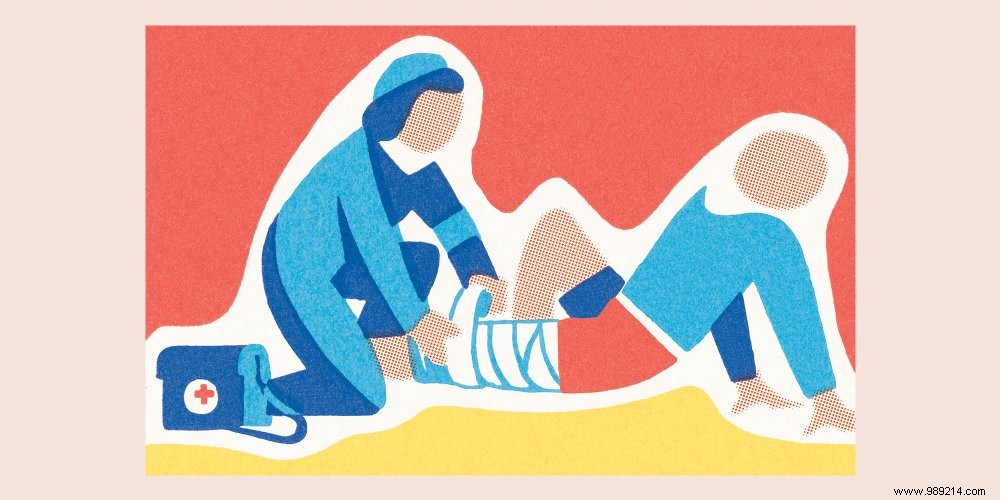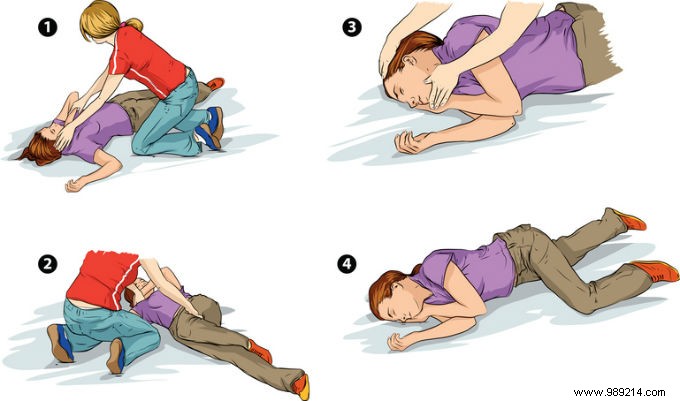 61% of French people do not have the reflex to perform cardiac massage in front of an unconscious person who is not breathing more. Dr. Pascal Cassan, national adviser of the French Red Cross, explains to us the gestures that save.
61% of French people do not have the reflex to perform cardiac massage in front of an unconscious person who is not breathing more. Dr. Pascal Cassan, national adviser of the French Red Cross, explains to us the gestures that save. Each year, 1 million people are victims of domestic accidents in France, and 20,000 die. 80% of accidents occur at home and unfortunately, still "61% of French people do not have the immediate reflex to perform cardiac massage when faced with an unconscious person who is no longer breathing", warns the French Red Cross.
Figures that the institution wishes to use to raise awareness and mobilize the population on the gestures that save while waiting for help (the firefighters generally arrive in 7 minutes, 15 minutes for the Samu).
Pascal Cassan, National Medical Advisor of the French Red Cross and author of First Aid for Dummies (Ed. First) explains how, through simple techniques and maneuvers, we can all one day be able to save a life.
"It's a dramatic situation but one that is easy to take care of when you know what you have to do and how to do it well", explains doctor Pascal Cassan. Generally, the chances of survival are proportional to the number of people trained in first aid.
"First of all, it is essential to recognize the cardiac arrest:the person suddenly collapses, is unconscious and no longer breathing. It is then necessary to act immediately because every minute, the victim loses 10% chance of survival. The goal is to help him until help arrives."
In this situation, three actions are to be put in the head:
"Calling the emergency services only allows us to help the victim, but also to help the person in the process of providing assistance. It is very important support because he will explain to me how to do cardiac massage, which I have already practiced or not."
Good gestures? Locate the middle of the victim's chest (where the sternum is). Position the heel of one hand there, then place the other on the first. Stand over the victim and press 120 times per minute. We will help the victim until help arrives. If a defibrillator is nearby, it can be used. Very well designed and easy to use, all you have to do is follow the instructions on the device:stick the electrodes, step aside and the device then decides whether or not to send an electric shock.
A person dies of a heart attack every ten minutes in France.
Unlike cardiac arrest, a person who has suffered a malaise is still breathing.
"The first thing to do is to position it on its side, in a lateral safety position (unless it has suffered a traumatic shock such as a car accident or a fall from several floors). Above all, the victim must not be left on his back. because she can vomit or 'drop' her tongue back, which risks obstructing her airways", advises the doctor.

lukaves / iStock
Once again, three gestures are to be made:press / lengthen / alert
"In the event of a total section of a limb such as a finger, a hand, an arm or a leg, the first thing to do is to stop the bleeding. At first, therefore, it is necessary to press on the place which causes to bleed in order to avoid hemorrhage. Then, the victim must be laid down because the hemorrhage causes a loss of pressure in the body and the blood no longer irrigates the brain sufficiently. And finally, we alert the emergency services.
And the member, what do we do with it? "We place it in a cloth or a clean plastic bag (freezer bag type) to protect it before putting it on a bed of ice. If it is not protected from the cold, there is a risk of damaging the tissues. We don't avoid putting it in the fridge. Once in the hospital, a surgeon can reimplant it," explains Dr. Cassan.
"At the crossroads between the respiratory and digestive tracts, between the esophagus and the trachea, there is a valve which when you breathe sends the air to the lungs and when you swallow sends food towards the stomach. If you swallow the wrong way, a foreign body can act as a plug by blocking this valve and preventing you from breathing."
No more sound comes out of the victim's mouth, she is speechless and no longer breathing, she then risks death by suffocation.
"We must act quickly to avoid cardiac arrest", warns our expert. Two gestures can allow an effective unblocking of the respiratory airways:tap about 5 times between the shoulder blades or proceed with the Heimlich manoeuvre.
How to do ? Stand behind the victim, put one point at his stomach, and the other on the first, press back and up to send air to expel the foreign body. For a child, press in the middle of the chest 5 times in a row.
Burns are very frequent accidents and unfortunately, people often use anything to treat them:fatty substances such as butter, ointment, cucumber! These are stupid ideas. The fat, for example, maintains the heat", protests Pascal Cassan.
The reflex to have is simply to water to prevent the formation of a blister, he advises. "Under running water, not too cold. If the burn is larger than the victim's hand, you should call the emergency services for advice or take them to the hospital if they are serious. You can then apply a suitable product, recommended by a doctor or pharmacist."
In the event of a wound, two reflexes are to be adopted:wash your hands, whether you are taking care of yourself or the victim, to eliminate germs. Then, the wound is washed with water (to which Marseille soap can be added) to remove 80% of the microbes. On the other hand, alcohol is avoided (because of the tingling or burning sensations it causes). Thereafter, we can possibly use a disinfectant that a health professional advises us.
Protect with a bandage. In the following 2-3 days, we check that the wound does not redden, that it does not become hot and that it is not painful because this can be a sign of an over-infected wound. You should then consult a doctor.
Introduction to lifesaving gestures (for young and old), cardiac emergencies and a specific module on the prevention of everyday life accidents (PREVIC) are on the program for World First Aid Day, which takes place every year in September.
But learning the actions that save can be done all year round. Level 1 civic prevention and relief training (PSC 1) is offered throughout France (from 10 years old). For 8 hours, you can learn how to manage different accident situations and learn about risk reduction. At the end, you obtain by equivalence the European First Aid Certificate (BEPS).
Various initiations are also offered:first aid, child and infant first aid, well-being and autonomy, self-protection, basic gestures.
Read also: